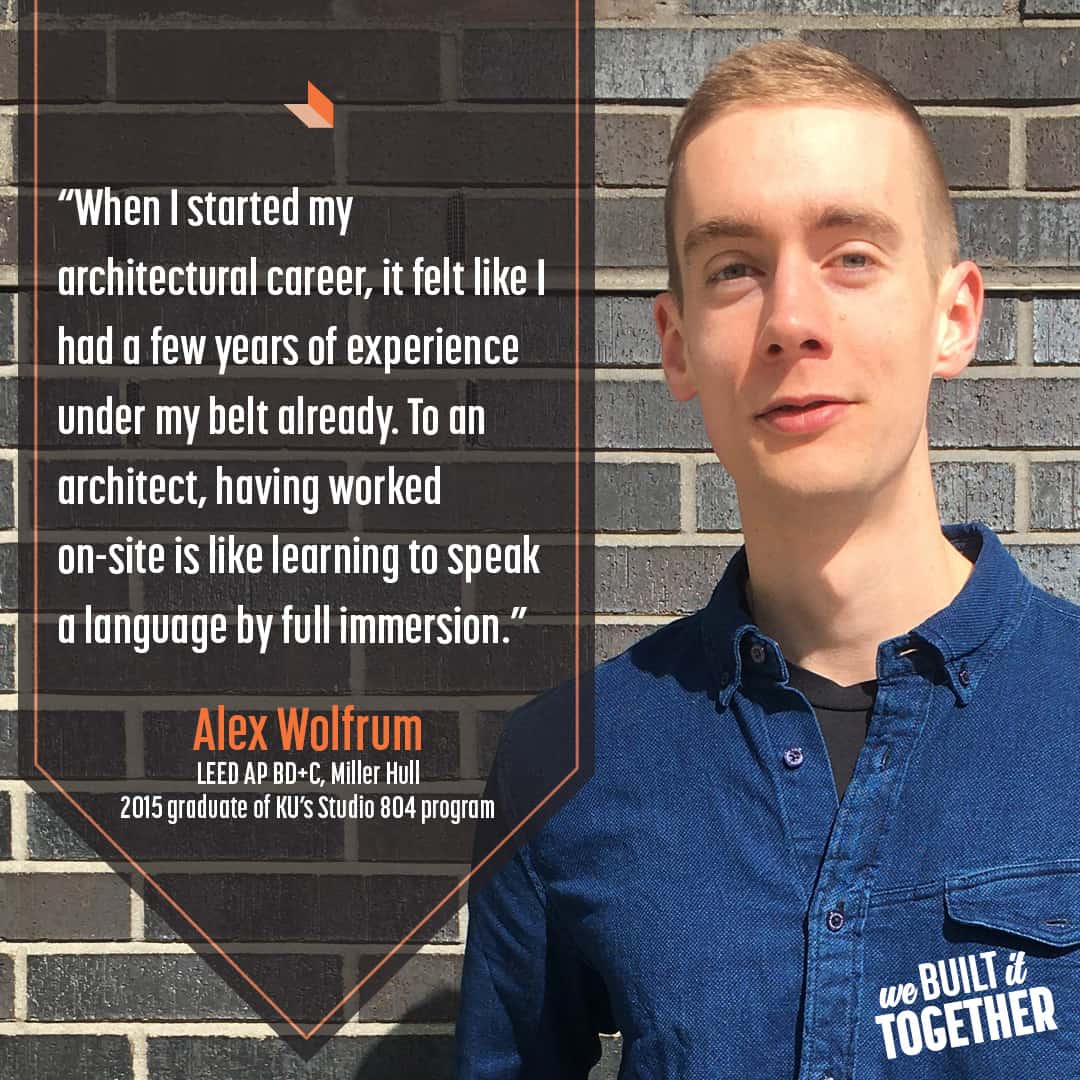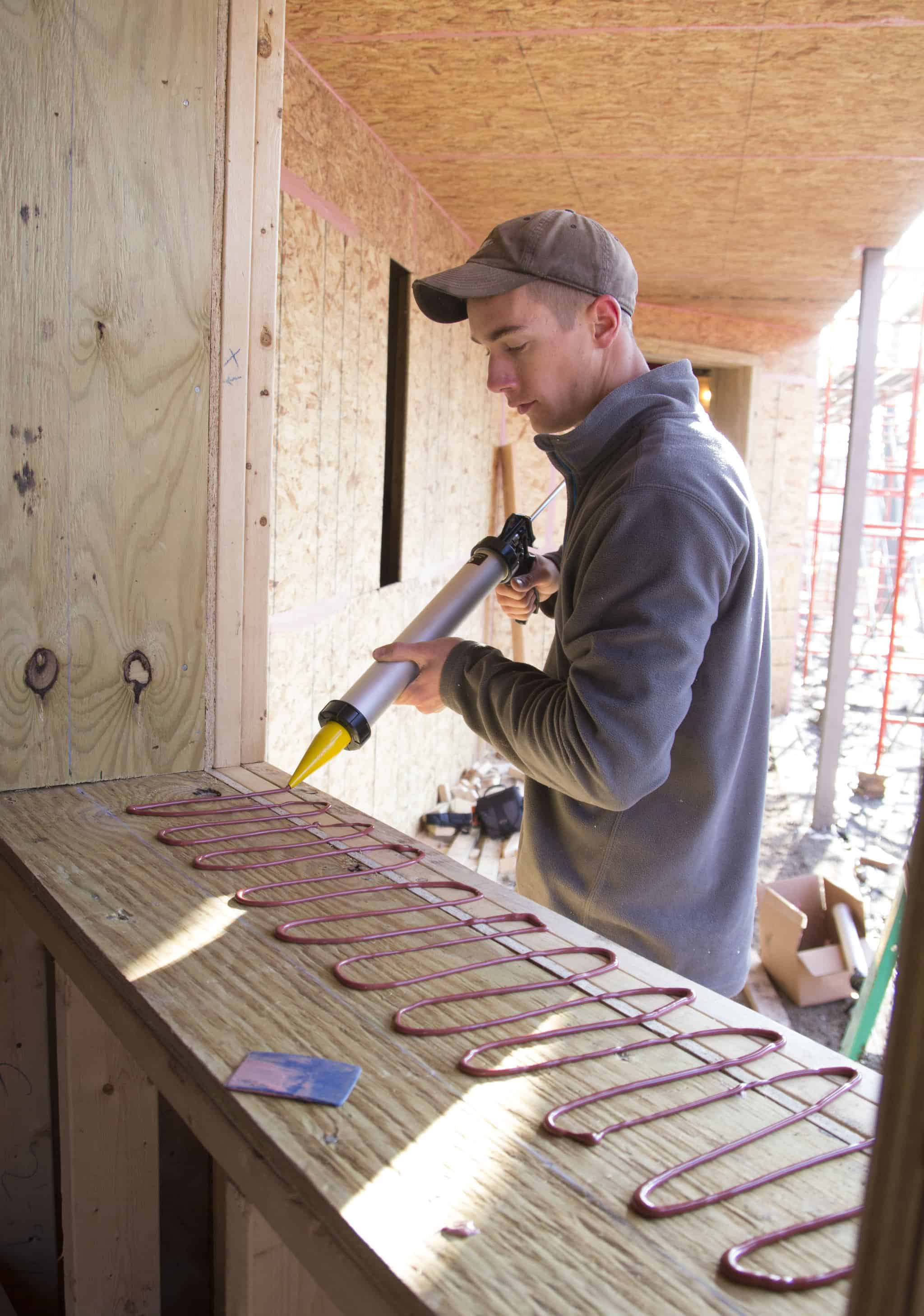Alex Wolfrum was part of the 2015 class of KU Architecture's world-recognized program called Studio 804, where graduate architecture students complete a design-build project from start to finish, learning everything about not only the design process but also the hands-on installation of all building products.
Today, Alex is a LEED AP BD+C at Miller Hull in Seattle, a firm renowned for its focus on energy-efficient and Passive House designs.

We caught up with Alex earlier this year and asked him about his current role, what a typical day is like for him at Miller Hull, and what he appreciates most about his college experience and Studio 804 in retrospect.
1) Starting back before KU and Studio 804, what inspired you to go into architecture/construction?
AW: I’ve always been excited about making things by hand, almost anything. As a kid I took a lot of art and shop classes working with wood, clay, glass, and metals. I think this was a natural transition to the hands-on approach of Studio 804 and KU architecture school in general.
2) What field were you originally imagining when you started college?
AW: I was always planning on architecture. I joined the KU five-year masters of architecture program out of high school and only applied to other architecture programs.
3) As an undergrad, what was your awareness of Studio 804? Was it something you always wanted to do?
AW: When I got to KU, it was right around the time that Studio 804 kicked off some of their more ambitious projects. Prior to the Greensburg, KS Art Center, they had worked exclusively on single family homes. My freshman year in 2010, they started a string of four Higher-Ed buildings that were like no other student projects around the country. Once I was able to tour projects like the KU Center for Design Research and the Ecohawks Research Facility, I knew that I wanted to be a part of it.
4) What’s the most important thing you experienced/learned in Studio 804 that helped prepare you for what you do today?
AW: The most important thing I learned from Studio 804 was accountability for my work and reliance on my classmates. I think for most of us it was the first time collaborating with so many voices at the table. Besides just gaining confidence in my abilities, it was great exposure to a range of products and tools that I now detail for others to install. When I started my architectural career, it felt like I had a few years of experience under my belt already. To an architect, having worked on-site is like learning to speak a language by full immersion.
5) If you could go back and do Studio 804 again, what, if anything, would you do differently?
AW: I'm proud of what we achieved on the 1301 New York house but if I were setting goals for it now, the first thing I would do is work to eliminate Red-List chemicals from the project. The pace of Studio 804 and reliance on donated or left-over materials made this difficult in some cases.
6) What advice would you give yourself back then, w/ the perspective and experience that you have five years later?
AW: I would tell myself to take more chances. All of my professional growth and opportunity came when I was in over my head or applying for a job I wasn't qualified for yet.
7) What was surprising to learn that you or a classmate didn’t know how to do as a master’s of architecture student (22+ years old-ish)?
AW: Maybe just how to work in an office? Most of my friends had done internships with big architecture firms before graduation so they knew what to expect their first day of work. My only professional experience was with a sole-practitioner in a very different setting.
8) Do you keep in touch from other Studio 804 2015 grads? If so, how many of them are working in construction or architecture?
AW: I haven't kept up with everyone like I should, but most that I know of are still in a related field. There are at least four other 804 grads with me in Seattle at a mix of design and construction firms.

9) What is the most interesting thing a classmate from Studio 804 is doing?
AW: I heard one of my classmates was studying to be a priest, that's hard to top for most interesting.
10) I know when we first spoke you were interested in going into sustainability. What drew you to that side of the industry?
AW: Obviously climate change and the role the construction industry plays in it was a big motivator, but it can seem like an overwhelming issue and I didn't know where to start. My third year in architecture school, the Bullitt Center (the first office building to earn Living Building certification) was completed and Margaret Sprug, an architect from Miller Hull, visited KU to give a lecture on it. After that, I only wanted to work on high-performance buildings. That was a big motivator for our Studio 804 project to certify as LEED Platinum and a Passive House. We wanted to set a high bar that others could strive for.
11) Tell me a little bit about your experience in Alaska and how that led to your current job at Miller Hull.
AW: My work in Alaska was totally serendipitous and I'll always be glad I was able to be a part of. The project came up because a professor of mine had a contact who was a rammed-earth builder doing a project for the Aleutian Housing Authority outside of Palmer, AK. They had a tight budget and wanted cheap (but not totally inexperienced) labor, so after graduation, six KU architecture students flew up there and worked from July through October to build a house using this uncommon construction method. The experience was really valuable even though I may never get to design a rammed-earth project. The two-foot thick insulated rammed earth assembly acts as a mass wall and needs no weather barriers applied to it, but due of the extreme climate, the designers specified R-guard products on the roof.
12) What is it like out there right now (or whenever you were job hunting) for people with your experience in finding a job? I’m curious what the job market is like for people with this background.
AW: As I write this, Seattle has 59 cranes in the sky, the most of any U.S. city, and six months ago that number was 65. Architects here are lucky to be busy, and I had no problem getting interviews. When I didn't find the right fit initially I stayed on the construction side for a few months, salvaging wood from an old house that was being remodeled. When Miller Hull called me back, I knew that was where I wanted to go.
13) What’s a typical day for you at Miller Hull?
AW: A typical day depends on the project and what phase it's in. Recently, I've been working construction administration for the Hans Rosling Center on the University of Washington's campus. We're using integrated design-build as the delivery method, which involves our team being colocated on site with the design engineers, general contractor, and other trade partners. For this project, most of my time was spent on the curtainwall scope: from expressing our design intent to the manufacturer, to coordinating shop drawings, to reviewing the performance mockup as it was tested with simulated wind and rain. It's different from the way design/build worked in Studio 804 but the idea of increased reliance on other team members is the same and has really helped us find efficiencies while still achieving great results.
14) What’s your favorite project you’ve worked on so far at Miller Hull?
AW: I've liked them all but my favorite project has to be the Kendeda Center at Georgia Tech. I finally got to work on the Living Building I'd been chasing.
15) I found this when Googling your name to try to get in touch: “The 2020 Bob Hull Research Grant awardee is Alex Wolfrum and his proposal PreOccupied.” Can you elaborate a little about this project, and was it an individual initiative by you, or what prompted it? Is it already in the works? (Also, congrats!)
AW: Thanks! Three years ago, Miller Hull established a grant for employees to pursue their interests outside of the day-to-day work. All full-time staff can submit a proposal and each year one is awarded with a cash stipend and time allotted to work on it. This year I was lucky enough to have my proposal selected, and I'm working on a series of post-occupancy evaluations on Miller Hull's past projects. As architects, we don't always have the chance to revisit our completed work, but understanding these buildings will help design teams deliver better projects in the future. My research will focus on the intersection of buildings, users, and the environment - what architecture is all about.
![]()